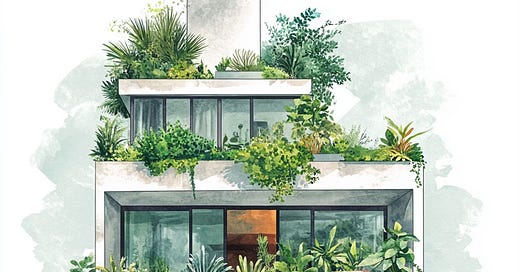When I first heard the term “biophilia,” I thought, Oh great, another word for ‘just add plants.’ But wow, was I wrong.
Yes, greenery is part of it, but biophilia goes so much deeper. It’s about reconnecting with nature in a way that feels so instinctive—because it is.
For me, learning about biophilia was one of those lightbulb “aha!” moments. Suddenly, I understood why my nervous system feels so calm when I’m in nature, why I crave sunlight and open spaces, and why weekend walks with my dog to the highest point in the park are a must (hello, prospect principle—more to come on that!).
It’s not just a preference—it’s biology.
Our bodies and minds evolved in natural environments. These experiences are deeply rooted in our biology and still influence us today. We can’t escape it! Biophilic design bridges the gap between these natural instincts and modern living, creating spaces that heal, inspire, and energise.
What is Biophilia?
Biophilia literally means “love of nature.”
Popularised by biologist Edward O. Wilson, it describes our innate tendency to connect with the natural world. And let’s face it—we’ve all felt this.
Ever walked into a lush, sunlit room and instantly felt relaxed? Or sat under a tree and found yourself breathing just a bit slower? That’s biophilia in action.
For me, this concept hit home when I realised how much better I feel in nature versus, say, a concrete-heavy city block. A year living in a modern (ahem: concrete box) building in the heart of London left me constantly on edge. I couldn’t quite catch my breath—it was like I was stuck in “on” mode.
Now, I live in West London, surrounded by greenery, cultural buildings, and so much more. I’ve also brought biophilic elements into my home—soft natural light, greenery, calming textures, and organic patterns. It’s like flipping a switch. My home has become my sanctuary, where I can take that deep, restorative breath I’d been missing.Plus, it is so much prettier now!
For someone who has two businesses and is always on the go, creating a space where my nervous system can rebalance is everything.
The Science Behind Biophilia
Here’s where my inner science nerd kicks in—because biophilia isn’t just a “nice to have.” Decades of research show that exposure to nature, or even its patterns, has measurable benefits:
Stress Reduction
Walking in a forest significantly lowers cortisol levels compared to urban areas, according to a 2015 study. (Cortisol is your body’s stress hormone, and let’s be honest—we all have enough of that.)
Natural environments activate the parasympathetic nervous system—the part that says, “Hey, you’re safe. Relax now.”
This explains why I feel so much calmer during my daily park walks . It’s like hitting the reset button.
Improved Focus and Creativity
Kaplan and Kaplan’s Attention Restoration Theory suggests natural environments restore our ability to focus by reducing mental fatigue.
Offices with plants are 15% more productive, according to research from the University of Exeter. (Plus, plants make your office way less boring!)
No wonder I get my best ideas after spending time in nature.. Nature fuels me—it’s where my creative flow kicks in.
Mental Health Benefits
Exposure to nature decreases symptoms of anxiety and depression, according to a meta-analysis.
Research shows that viewing fractal patterns reduces stress by up to 60% because they align with the brain’s natural processing pathways, requiring less cognitive effort.
Next time you’re feeling stressed, try staring at ripples on a pond or the branches of a tree. Those fractals are working their magic… and what amazing magic it is.
Faster Recovery
Patients with views of nature recover faster and need less pain medication, according to a landmark study by Roger Ulrich. Wouldn’t it be amazing if more hospitals were built with this in mind? Imagine the recovery speed.
So, biophilia isn’t just anecdotal. The benefits of nature on our biology are measurable and we can all do little things to bring some of it to our life.






Thank you Shreya for this refreshing perspective on biophilia! I appreciate how you've expanded the concept beyond just adding plants to our spaces, showing its true depth and multidimensional nature.
Your article articulates how our connection to nature encompasses all our senses and extends to forms, patterns, materials, and even social connections. The way you've connected scientific insights with practical applications is both inspiring and actionable. This broader understanding of biophilia has genuinely shifted my perspective on creating nurturing environments.
Your holistic approach resonates deeply, and I'm excited to apply these principles in my own life. Looking forward to more of your insightful writing that bridges science with everyday wellbeing!